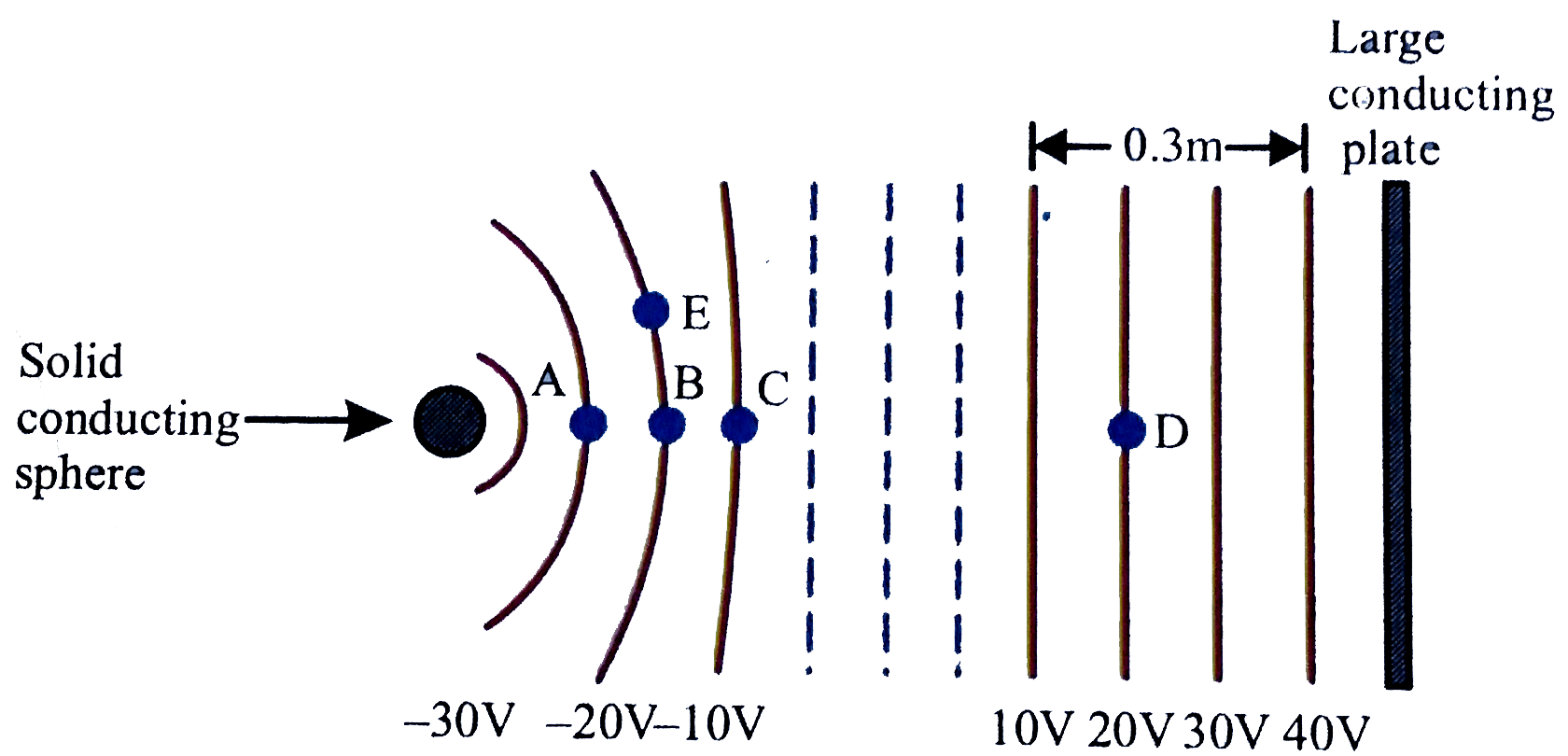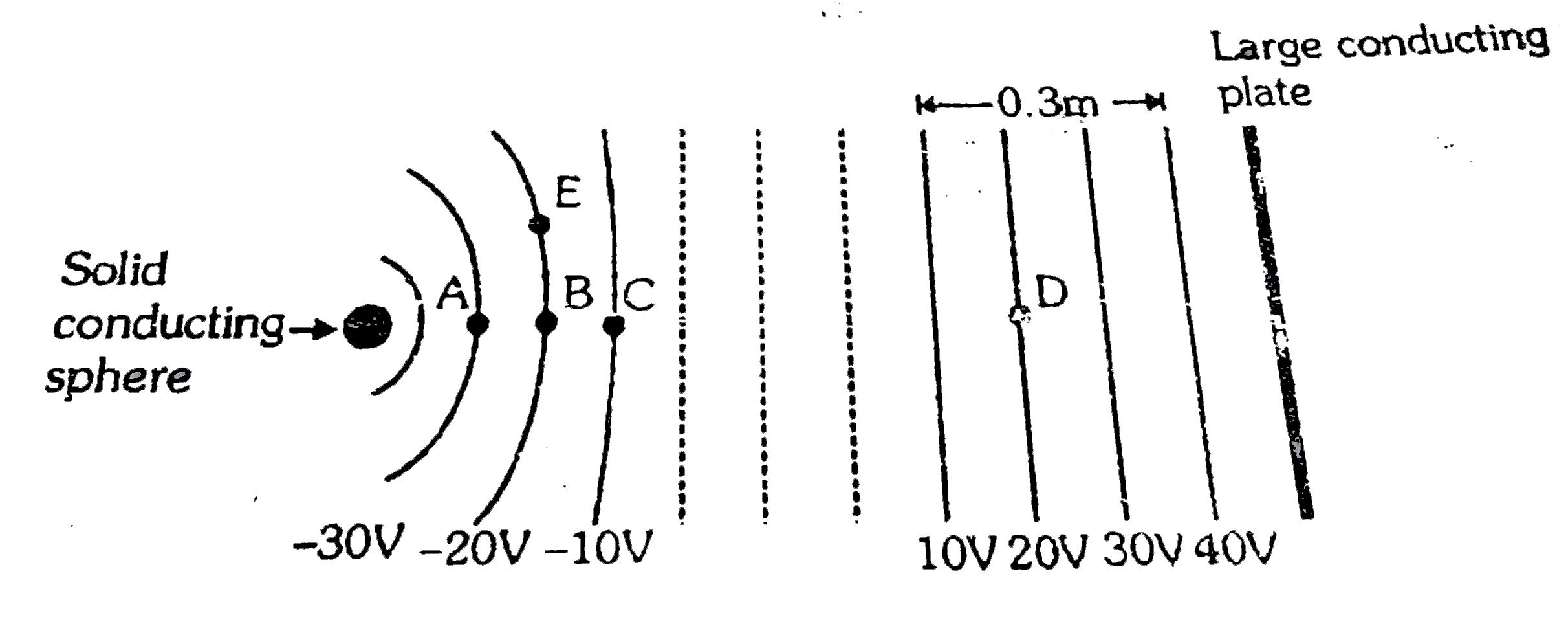The sketech below show cross secion so equipotential surfaces between two charged.Conductors that are shwon in solid black.Some points on the wquipotenital surfaces .near the conductors are marked as A,B,C….. The arrangements lies in air (Take ε0=8.85×10−12C2/Nm2]
![The sketech below show cross secion so equipotential surfaces between two charged.Conductors that are shwon in solid black.Some points on the wquipotenital surfaces .near the conductors are marked as A,B,C…. . The arrangements lies in air (Take epsilon(0)=8.85xx10^(-12)C^(2)//Nm^(2)] A positive charge is placed at B,When it is released:](https://d10lpgp6xz60nq.cloudfront.net/physics_images/NAR_PHY_XII_V02_C02_E01_388_Q01.png)
A positive charge is placed at B,When it is released:
no force will be exerted on it
it will move towards A
it will move towards C
it will move towards E
The correct Answer is:B
Positive charge has a tendency to move from higher potential to lower potential hence it will move from B(−20V) to A(−30V).
Topper's Solved these Questions
- BOOK - ALLENCHAPTER - MISCELLANEOUSEXERCISE - Comprehension 73videos
MISCELLANEOUS
- BOOK - ALLENCHAPTER - MISCELLANEOUSEXERCISE - Comprehension 84videos
MISCELLANEOUS
- BOOK - ALLENCHAPTER - MISCELLANEOUSEXERCISE - Comprehension 55videos
MISCELLANEOUS
- BOOK - ALLENCHAPTER - KINEMATICS (MOTION ALONG A STRAIGHT LINE AND MOTION IN A PLANE)EXERCISE - BEGINNER S BOX-78videos
KINEMATICS (MOTION ALONG A STRAIGHT LINE AND MOTION IN A PLANE)
- BOOK - ALLENCHAPTER - PHYSICAL WORLD, UNITS AND DIMENSIONS & ERRORS IN MEASUREMENT EXERCISE - EXERCISE-IV8videos
PHYSICAL WORLD, UNITS AND DIMENSIONS & ERRORS IN MEASUREMENT
Similar Questions
A point charge of 4.427 μC is at the centre of a cube Gaussian surface 9.0 cm on the edge. Find the net electric flux through the surface. (ε0=8.854×10−12C2N−1m−2)
View SolutionThe surface density of charge on the surface of a charged conductor in air is 0.885μC/m2. If ε0=8.85×10−12C2/N−m2, then the outward force per unit area of the charged conductor is
View Solution
Knowledge Check
- Question 1 - Select One
The sketech below show cross secion so equipotential surfaces between two charged.Conductors that are shwon in solid black.Some points on the wquipotenital surfaces .near the conductors are marked as A,B,C….. The arrangements lies in air (Take ε0=8.85×10−12C2/Nm2]

Surfaces charge density of the plate is equal toA8.85×10−10C/m2B−8.85×10−10C/m2C17.7×10−10C/m−2D−17.7×10−10C/m(2) - Question 2 - Select One
The sketch below shows cross-sections of equipotential surface between two charged conductors that are shown in solid black. Some points one the euquipotential surface near the conductors are marked as A, B, C ………. The arrangement lies in air. [Take ∈0=8.85×10−12C2/Nm2]

How much work is required to slowly move a −1μC charge from E to D?A2×10−5JB−2×10−5JC4×10−5JD−4×10−5J - Question 3 - Select One
The surface density of charge on the surface of a charged conductor in the air is 26.5μCm−2 . The the outward force per unit area of the charged conductor is (ε0=8.85×10−12C2N−1m−2)
A3.5Nm−2B17.7Nm−2C8.85Nm−2D39.7Nm−2
The displacement current density across a parallel plate air capacitor which is being charged at the rate of 1012V/m/s is (ε0=8.85×10−12C2N−1m−2):
View SolutionA metal plate of surface area 2m2 is charged with √8.85μC. What is the mechanical force acting on the plate if it is kept in air ? [ε0=8.85×10−12C2]
View SolutionEach plate of a parallel plate condenser has surface area of 5cm2. The distance between the plates is 2 mm. The dielectric constant of the medium between the plates is 5. Then the capacity of the condenser is
(ε0=8.85×10−12C2/Nm2)View SolutionThe surface density of charge on a conductor situated in air, is 2×10−4C/m2. The electric intensity at a point very near to its surface is
View SolutionA parallel plate capicitaor with plates of area 1m2 each, are at a separation of 0.1m. If the electric field between the plates is 100 N/C, the magnitude of charge on each plate is : (Take ε=8.85×10−12C2N−m2)
View Solution

